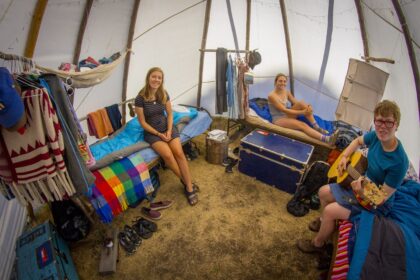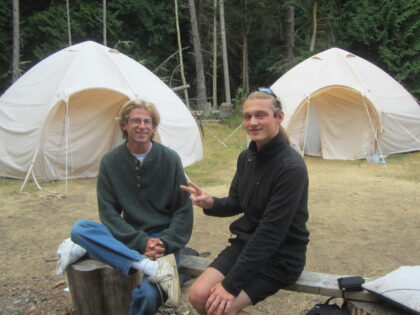A Canvas Home
 We have several different lodging structures in use on property. Our 9-10 year-old camper live in canvas tents on platforms that house four campers each. Across the rest of the units (ages 11-16), we use one of three types of structures: tipis, bell tents, and air dome tents. Most of these house three campers each, with some four-person tipis in the mix as well.
We have several different lodging structures in use on property. Our 9-10 year-old camper live in canvas tents on platforms that house four campers each. Across the rest of the units (ages 11-16), we use one of three types of structures: tipis, bell tents, and air dome tents. Most of these house three campers each, with some four-person tipis in the mix as well.
Living in a canvas home is a unique experience—you’ll learn how to make it comfortable, how to keep it tidy and how to keep it dry inside if it’s raining outside. Plus, you’ll make great new friends with your tent or tipi-mates!
 All campers will have their own bed frame, foam mattress and mattress cover. It’s up to you to bring your pillow, sleeping bag and maybe a light blanket for warmer nights. We get creative with organization and set-up during our four weeks at Camp – using bins or hanging shelves to keep clothes organized, or using a round of cut wood for a nightstand. The bell tents and air domes also have a closet frame set-up inside each of them to make set-up a bit smoother in structures without internal framing.
All campers will have their own bed frame, foam mattress and mattress cover. It’s up to you to bring your pillow, sleeping bag and maybe a light blanket for warmer nights. We get creative with organization and set-up during our four weeks at Camp – using bins or hanging shelves to keep clothes organized, or using a round of cut wood for a nightstand. The bell tents and air domes also have a closet frame set-up inside each of them to make set-up a bit smoother in structures without internal framing.
 We all work to keep our living spaces tidy and safe – inspections happen at least once a week – and it’s an important life lesson to make a habit of tidying up your space daily, especially when you share that space with others.
We all work to keep our living spaces tidy and safe – inspections happen at least once a week – and it’s an important life lesson to make a habit of tidying up your space daily, especially when you share that space with others.
 Typically, a Unit is made up of 4-5 camper structures and two staff structures. Each unit, whether in tents or tipis, has its own space, somewhat separate from the other units. The tents and tipis in a unit generally form a circle, with all doors facing in towards the unit’s fire circle. The fire circle is a central space for gathering whether it’s to discuss or plan an upcoming unit activity or to roast s’mores together in the evenings.
Typically, a Unit is made up of 4-5 camper structures and two staff structures. Each unit, whether in tents or tipis, has its own space, somewhat separate from the other units. The tents and tipis in a unit generally form a circle, with all doors facing in towards the unit’s fire circle. The fire circle is a central space for gathering whether it’s to discuss or plan an upcoming unit activity or to roast s’mores together in the evenings.
A unit’s space is very integral to the camper experience – it’s where you come “home” each night, where you sleep and keep your belongings, where you get prepared for each day’s activities, and the main physical place that you connect and bond as a unit. Important growth and connection happen here, so it’s important to care for it and keep it a comfortable space for all members of the unit.
Our entire community at Camp Nor’wester has the rare and beautiful opportunity to live in tipis and platform tents each summer. Tipis have been the living structure most associated with camp since its inception in 1935.
Why do we live in tipis?
- We love being close to nature, with the bare earth beneath our feet and the sun filtering through the canvas.
- Living in tipis together helps to promote engagement between campers and staff on a more intimate level, resulting in deepened friendships and heightened awareness regarding community living.
- The sturdy structure of a tipi and its conical shape withstand wind and rain yet allow air to move through, helping us immerse in nature with humble respect.
- We utilize our resources on camp land to make poles and have the ability to place tipis in precarious places that otherwise would not accommodate a living structure.
- We strive to live light on the land and we allow the property to go back to its natural state for nine months before setting up tipis once again. This cycle also allows for flexibility in placement, fluidity in programming and an honoring of the land.
We acknowledge, with full transparency, that tipi structures originated in the Great Plains region of the United States and Canada within the Plains Native Culture. Nor’wester does not have an authentic connection or tie to this culture, so we are currently in discussion about what it means for us to continue our tradition of living in tipis. We are striving to educate our community and choose to continue to move into the future with sensitivity, compassion and intention around all things we do.
We acknowledge that there is a fine line between cultural appreciation and appropriation. Our C5 Board Committee (Creating Cultural Competence in our Camp Community) and members of camp leadership are dedicated to continued conversation about this topic and seek to understand all voices in the community as well as societal and cultural observations from outside the community.
We acknowledge that Camp Nor’wester’s love of indigenous culture over the years has solidified tipis as part of our story and sense of place since 1935. This love and appreciation also means that we may need to let go of some things that have been a tradition in our community in order to stay consistent with our values, acting in the utmost integrity as we move into our sustainable future.
Lodging Structures at Nor'wester - Current Updates for Summer 2024
In the fall of 2021, the Nor'wester Board of Directors voted to transition away from tipis as the primary lodging structure used in our summer program. A small work group formed in 2020 to explore suitable alternatives to tipis for use on property. Please see our Fall 2022 Newsletter to read a message to the Nor'wester Community regarding our ongoing tipi transition.
In the summer of 2022, custom bell tents were used in three units after a small trial run the previous summer. We also tested out an air dome tent model in two different units. In the summer of 2023, two units used air dome tents, and two units used bell tents.
Trials for additional structure types will be arranged for near-future summers, as we decide on suitable structures to test.
Shower houses: A center for sustainability
 Each side of camp has its own shower house. Water is heated daily by wood fires in the boilers, supervised by staff members only. Each camper will have a cubby in their respective shower house to store their toiletries and hang their towels. Campers will visit the shower house at least twice a day in the morning and evenings, and then are scheduled for showers twice a week. Showers are private stall and shower times are supervised by staff but staff shower at separate times from campers.
Each side of camp has its own shower house. Water is heated daily by wood fires in the boilers, supervised by staff members only. Each camper will have a cubby in their respective shower house to store their toiletries and hang their towels. Campers will visit the shower house at least twice a day in the morning and evenings, and then are scheduled for showers twice a week. Showers are private stall and shower times are supervised by staff but staff shower at separate times from campers.
 We practice water conservation at camp in an effort to minimize our consumption of resources and also to teach our community about sustainable practices that apply to life beyond camp. In addition, each unit gets to chip in and help take care of our facilities (approx. once a week) during “Shower house and Outhouse Joy”!
We practice water conservation at camp in an effort to minimize our consumption of resources and also to teach our community about sustainable practices that apply to life beyond camp. In addition, each unit gets to chip in and help take care of our facilities (approx. once a week) during “Shower house and Outhouse Joy”!
On the topic of outhouses, it’s important to know we do use them at camp, almost exclusively. We all work to keep them clean throughout the summer, and they are pumped regularly to maintain our waste. We have one outhouse near the lodge that actually uses composting technology to reduce the volume of waste. We think it’s pretty cool! 

